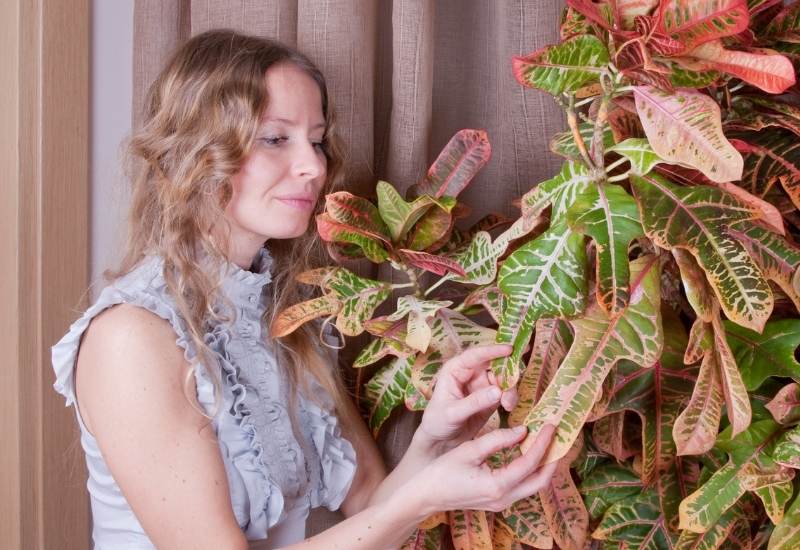
The croton plant (Codiaeum variegatum) is a tropical evergreen shrub known for its vibrant and impressive colored foliage. With over 100 amazing cultivars to choose from, the thick, leathery leaves of croton plants can come in a wide variety of shapes and colors.
Native to the open forests of Indonesia, Australia, Malaysia, and the western Pacific Islands, croton plants thrive in sunny conditions with average room temperatures. While they can sometimes produce small flowers, these are nothing in comparison the beauty of the croton plants fiery leaves.
How to care for croton plants?
Pot croton plants in a well-draining potting mix and place in a location with 6-8 hours of indirect sunlight per day. Mist the leaves often for increased humidity and water regularly to keep the soil moist. The ideal room temperature is between 60°F and 70°F (16° – 21°C). Croton plants are known to drop their leaves as a result of cold drafts.
Croton plants are a generally easy plant to care for. With careful attention to a few small details, they will reward you with amazing and lush tropical foliage.
To make sure your croton plant can reach its full potential, keep reading for a complete croton care guide, including planting, light, watering, feeding, and pruning.
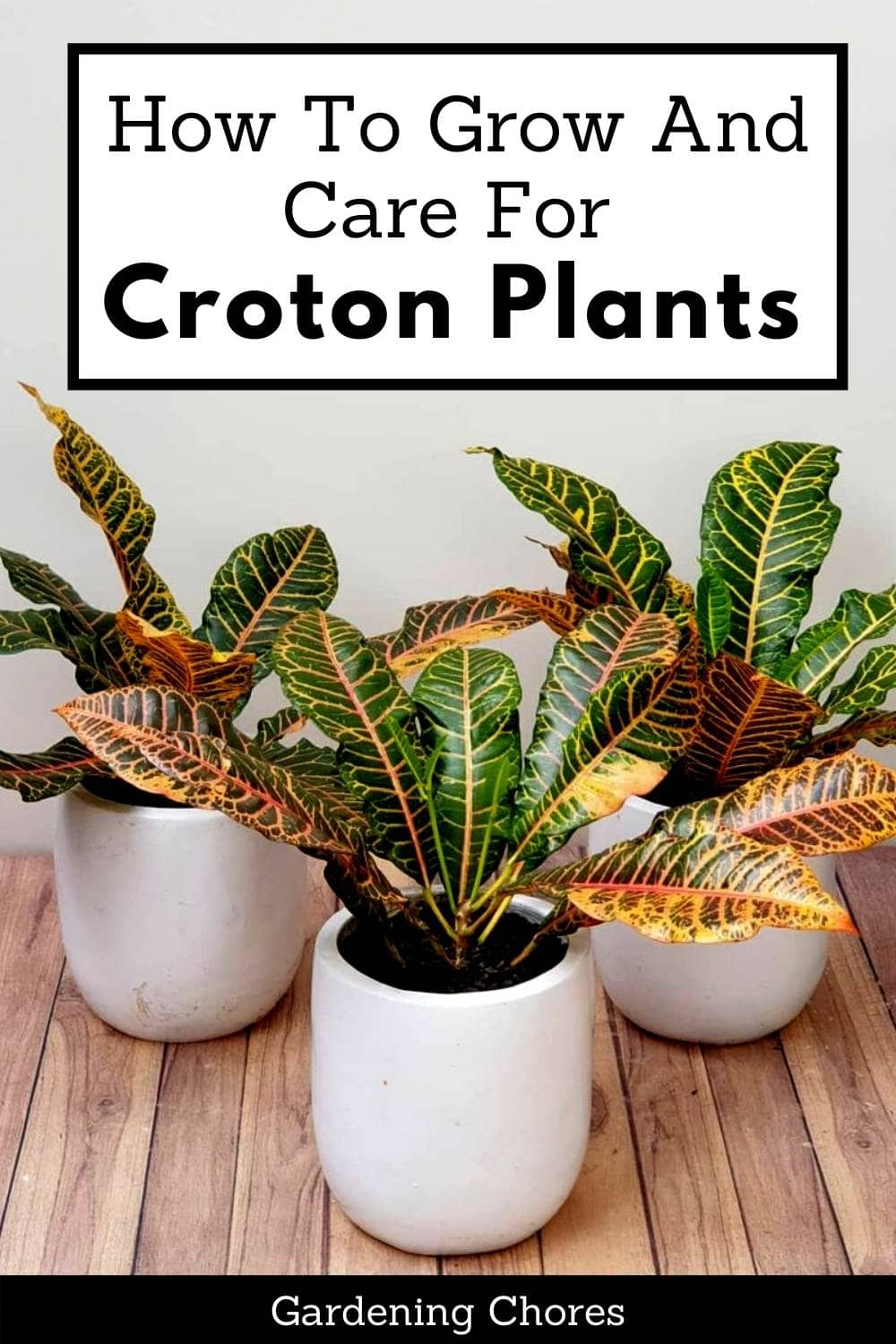
Croton Plant Overview
The croton plants we will be discussing in this article are a perennial evergreen shrub from the genus Codiaeum. This genus contains only a few species, but hundreds of different cultivars which are prized both as houseplants and in the garden for their spectacular colors and unique appearance.
Unfortunately, these croton plants (from the genus Cordiaeum) are often confused with plants from the genus Croton which contains over 1200 species of herbs, trees, and shrubs.
While they are related, both being from the Euphorbiaceae family of plants, they are entirely different.The croton plants that we will be discussing (Codiaeum variegatum), can be grown outdoors in USDA zones 10-11.
Here they are known to reach nearly 10ft tall with an impressive spread of up to 6ft. With their dense bushy appearance, croton plants are able to serve both as an eye-catching privacy hedge, or a stand-alone statement piece.
When grown indoors as a houseplant, potted crotons likely won’t grown any larger than around 3ft tall with a spread of about 2ft. Also known as fire croton, variegated croton, and garden croton, croton plants feature large, glossy leaves with pronounced veins and a variety of colors.
There are over 100 different croton cultivars available, each with their own unique and beautiful appearance. Some crotons have oblong leaves with a pointed tip, while others can be twisted, thin and skinny, and violin or oak-shaped.
Mature croton plants may produce some small white flowers, however they will be unimpressive and inconspicuous amongst the plants voluptuous exotic foliage.
Croton Plant Profile |
Botanical name: Codiaeum variegatum |
Common name(s): Fire croton, variegated croton, garden croton |
Plant type: Tropical evergreen shrub. |
Size: 10ft tall and 6ft wide as an outdoor plant. 3ft tall and 2ft wide when grown indoors. |
Sun Exposure: Plenty of bright, indirect sunlight. |
Soil Type: Well-draining, fertile soil. A mixture of potting soil, peat moss, and perlite is ideal. |
Soil pH: Neutral soil; 6.6 - 7.3 pH |
Bloom Time: Insignificant blooms in summer, rarely bloom indoors. |
Flower Color: White |
Hardiness Zones: 10 to 11 |
Native Area: Indonesia, Australia, Malaysia, and the western Pacific Islands |
How To Grow And Care For Croton Plants (Codiaeum Variegatum
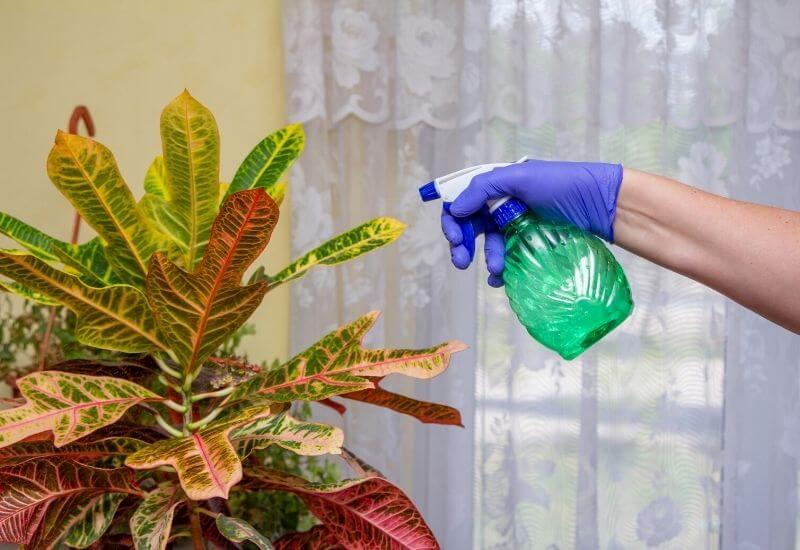
Croton plants are not the easiest of the houseplants to grow, but they really aren’t super difficult either. However, they are known for dropping their leaves when things aren’t quite right.
It is important to avoid temperature extremes, keep the soil moist but not waterlogged, and mist the leaves regularly to maintain the plants healthy and vibrant foliage.
To keep your croton plants happy and thriving here are a few important care factors to follow:
1. Plant Indoor Croton Plants In Rich And Well-Draining Soil That’s Full Of Nutrients
Croton plants like their soil to be fertile, as well as having excellent drainage. This way, the soil will allow excess water to drain while also holding enough moisture to keep the plant happy.
To produce the ideal soil conditions to plant indoor crotons, a combination of regular houseplant potting soil, peat moss, and perlite is best. You should also consider amending your soil with some compost when potting your croton plant for added nutrients. Make sure your pot has holes at the bottom for drainage as well.
As with most houseplants, the worst thing for a croton plant is making them sit in waterlogged soil. You can amend the soil with extra perlite if you find it is not drying quick enough.
2. Determine The Light Requirements Of Your Specific Croton Plant Variety
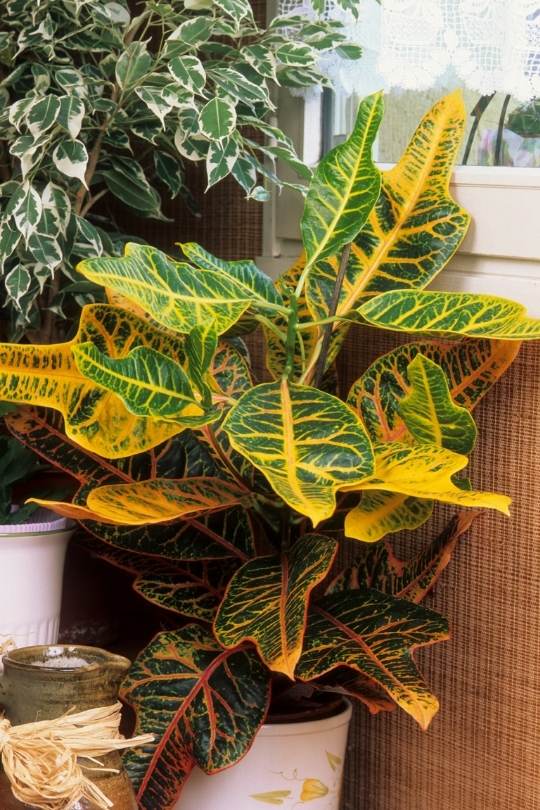
Croton plants require a lot of sunlight to thrive. Ideally, they should receive between 6-8 hours of indirect sunlight each day. You should always protect your croton from direct sunlight though, because it can be too harsh on the leaves.
Plenty of bright, indirect sunlight will keep the colors of your croton plant nice and vibrant, especially if it’s one of the many variegated varieties. The best location to achieve these conditions would be near a south or west-facing window.
If your croton plant is not receiving enough sunlight, the colors may appear faded or washed-out. A similar affect will also appear, along with leaf burn, if the plant is receiving too much direct light.
An easy solution to solve the problem of excess direct sunlight is to provide a sheer curtain or blinds over the window. This will filter the sunlight and create the ideal conditions for a croton plant to grow.
3. Water Frequently With To Keep The Soil Moist
Since croton plants come from a humid tropical environment, they prefer their soil to be consistently moist. They love to get plenty of water, but they do not want to sit in soggy soil.
You should only water your croton plant once the soil surface has dried. This may be about once per week in the summer months, or closer to once every 10-12 days in the winter.
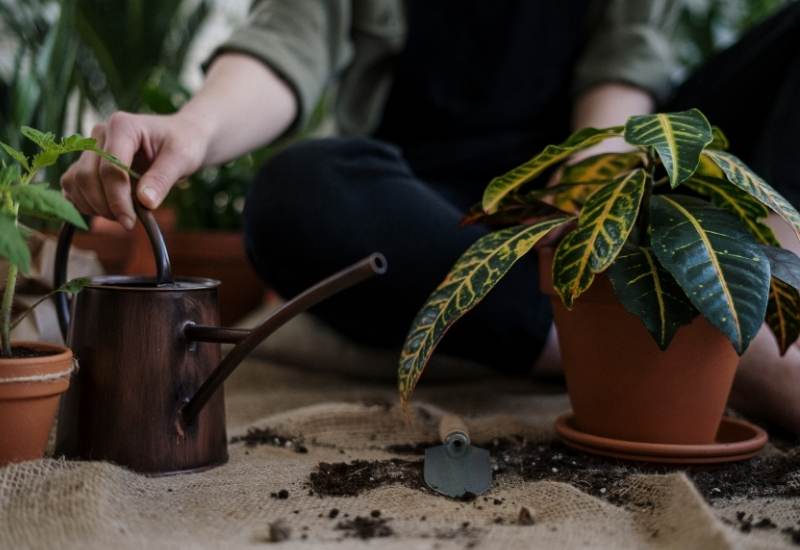
Watering too often will cause root rot and harm the plant. However, Croton plants are not drought tolerant either, meaning you should never allow the soil to become completely dry, or it’s beautiful foliage will begin to wilt.
Watering a croton plant is the most difficult part of its care requirements. The balance between keeping the soil moist, but not waterlogged can be a tough skill to master. Luckily croton plants are relatively hardy, so there is room for some trial and error.
Keep in mind that overwatering is often better than under-watering, since a quick transplant to some fresh potting soil is an easy solution to the problems associated with watering too much.
But, it is much more difficult for a plant to bounce back from a drought, especially if it is not drought tolerant like the croton.
4. Feed Croton Plants Once Per Month During Active Growing Periods
Croton plants require fertile soil and plenty of nutrients to maintain their lush, vibrant foliage. However, there is no need to feed them more than once per month, or you can risk salt build up in the soil and nutrient burn. Compost is a great option for avoiding these issues.
Feed croton plants once per month with a fertilizer that is high in nitrogen and potassium. Nitrogen encourages the growth of foliage, while potassium will provide the plant with everything it needs to create those bold and beautiful colors.
During the winter months most houseplants, croton plants included, will go mostly dormant. This means their growth will slow almost to a complete halt, and they will not be using as much water or nutrients as in the growing season.
During this time, you should only feed once every 2-3 months to avoid damaging the roots.
5. Keep The Croton Plants Around 60°F And 70°F
As a tropical indoor plant, crotons thrive in temperatures between 60°F and 70°F (16° – 21°C). The temperature of the room should never exceed 80°F (26°C), or fall below 55°F (12°C).
It is very important to keep your croton plant away from cold drafts, like from an old window, an air conditioning unit, or near an exterior door. Similarly, bursts of hot air from a heating vent can have negative affects on plant growth as well.
Croton plants can be grown outdoors as a decorative shrub in USDA zones 10 or 11. In temperate regions, you can even move your croton plant outdoors in the summer, as long as you are in an inland area which is protected from cool sea-breezes. Just as if the plant was grown indoors, it is vital that the temperature does not drop below 55°F (12°C).
6. Maintaining The Correct Humidity Level For Indoor Croton Plants
As a humid-loving plant, crotons require a humidity level of at least 40% to thrive. Since the air inside most homes tends to be dry, especially in the winter while the heating is on, it is important to provide an extra source of humidity for your croton plant.
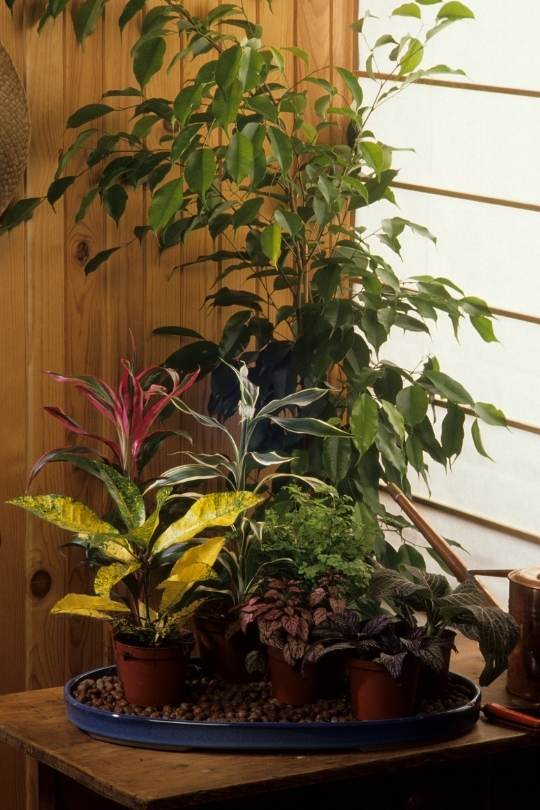
There are a few different methods to provide increased humidity for houseplants. Aside from using a humidifier, here are a few other useful tip to maintain a higher humidity around the plant:
Leaf drop is a common sign of incorrect humidity levels for croton plants.
7. Repot The Croton Plant During Spring Or Early Summer When It Outgrows Its Current Pot
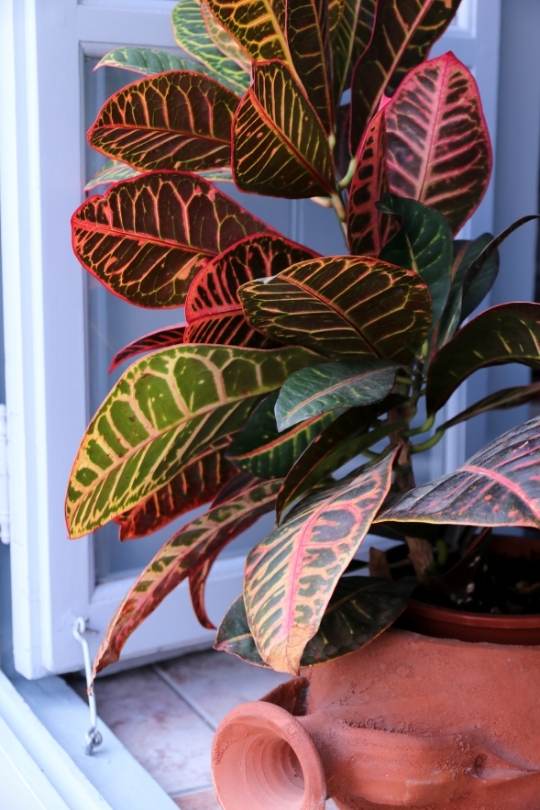
If your croton plant has become too rootbound then the soil will have become too compact, which will have a negative affect on drainage. This is a sign that is is time to repot your croton plant. The best time to repot a croton plant is in the spring.
You should repot your croton plant into a container that is only slightly larger than its current one. Jumping up to a much larger sized pot will leave a lot of excess soil which is untapped by the roots. Water will linger in these areas for much longer, which may eventually lead to pest and disease issues.
Once you have removed the plant from its old container, shake off as much of the old soil as you can. This is also a good time to examine the roots. Healthy roots should be white and will often even appear to be covered in tiny hairs. Unhealthy or dead roots will be brown or black and often slimy. You should pull off any unhealthy looking roots before placing the plant in its new pot.
Finally, place your croton plant in its new pot and fill with a fresh new batch of the appropriate soil mix. Press the soil down firmly to provide support for the plant, but not so hard that it will be too compacted for proper drainage. Water the plant in thoroughly to finish the job.
8. Croton Plants Require A Pruning Routine To Get That Bushy Look
Along with maintaining plant health, pruning is usually done as a way to keep a croton plant at a certain size, encourage bushiness of the foliage, or increase its density of branches. Since croton plants naturally have pretty dense foliage, pruning isn’t always necessary.
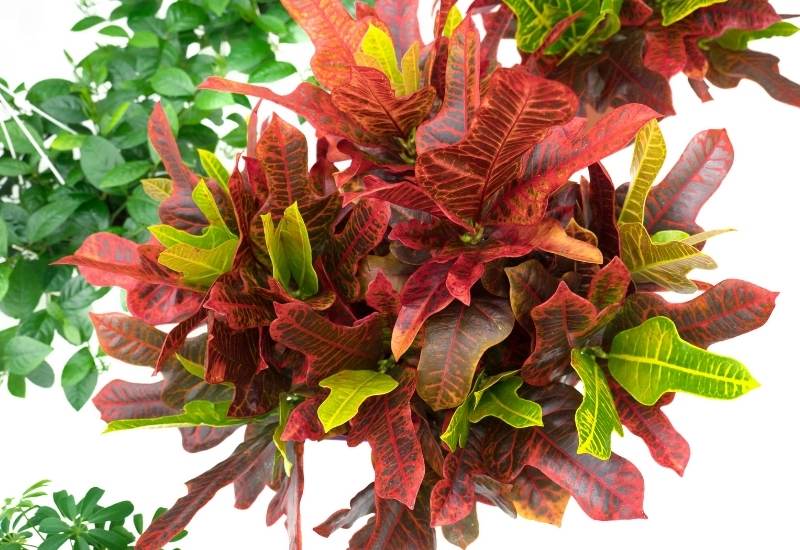
The best time to prune your croton plant would be in the spring, just before the growing season begins.
However, you should still remove any dead leaves or branches as they appear throughout the growing season to maintain good plant health. To remove a dead leaf, cut the stem at the point where it meets the plant. If you wish to trim back some branches, always trim them just above a node.
Since croton plants can easily grow 6-10ft tall, pruning is a good way to manage its height as a houseplant.
This can be done simply by cutting the main stem to the desired size. Remember that trimming off the top of a plant will often encourage the foliage to become even bushier, so make sure the plant has enough space to grow outwards.
When pruning a croton plant, you should always wear gloves to protect your hands from the milky white sap which will bleed from the plants wounds. This sap is known to cause skin irritation, as well as induce nausea and vomiting if ingested by humans or pets.
9. Propagate Croton Plants From Stem Cuttings
The best way to propagate croton plants is to use stem cuttings from a healthy, mature plant. Remember that croton plants will ooze milky white sap which can be irritating to the skin, so protective gloves are important when taking cuttings.
To propagate a new croton plant always start with clean, sharp, and sterile pruning sheers. Select a healthy stem which is around 3-4″ long and has at least 3-5 leaves on it. Make your cut just after the node on the mother plant.
Pot your croton cutting in a nursery pot with some loose potting soil to start. You should ideally keep the potted cutting in a warm environment (70° – 80°F is best). Placing a plastic bag over the cutting can help to create a warm and humid environment which is perfect for the cutting to thrive.
Keep the soil moist to encourage root development. If all goes well, the new cutting should be rooted and ready for transplant elsewhere in about a month.
10. Common Croton Plant Pests And Diseases
Healthy croton plants are fairly resistant to most common houseplant pests and diseases, however they can still be affected by a few if their ideal care conditions are not met.
Mealybugs, thrips, scale insects, or spider mites can affect croton plants on rare occasions. Each of these pests thrive on drinking the sap from the plant, which will weaken the plants growth and may eventually lead to death if the situation is not taken care of quickly enough.
There are many commercial insecticidal soaps and sprays available which can help control a pest problem.
There are also a few DIY options like wiping the leaves with a rubbing alcohol soaked cotton ball, or creating your own insecticidal spray using neem oil, dish soap, and water.
As for diseases, the only disease which is likely to affect a croton plant would be associated with root rot.
Waterlogged or soggy soil will cause the roots of your croton plant to decay and die. Usually, the first sign of root rot is when the plant begins to drop its leaves. This can easily be prevented with proper watering as described earlier in this article.
Croton Plant FAQ
Are Croton Plants Poisonous?
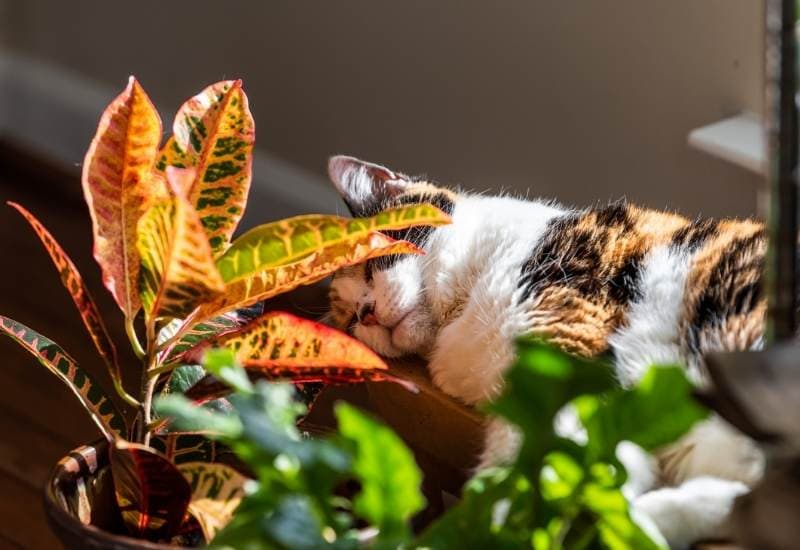
Yes, all parts of the croton plant are considered to be poisonous. The stems and leaves of croton plants contain a milky latex sap which is known to be toxic to dogs and cats. It has strong irritant and purgative properties, which means ingestion of this sap can induce nausea and vomiting in both animals and people.
The white sap will also cause skin irritation and dermatitis in humans, avoid contact with the eyes and wear gloves when pruning a croton plant. If the sap does come in contact with the skin, immediately wash the area with soapy water.
The seeds of croton plants can also be very dangerous, as they can be fetal to children if consumed. Always handle croton seeds with great care.
Do Croton Plants Have Flowers?
Yes, all species of croton plants can produces tiny star-shaped flowers which grow on thin, long stems. The cute little flower clusters are pretty adorable, but can be hard to spot amongst the dense, bushy foliage of croton plants.
However, these flowers will only appear on a croton plant which is grown outdoors. Croton plants which are grown indoors as a houseplant will rarely, if ever, produce flowers.
Why Is My Croton Plant Dropping Its Leaves?
The most common reasons for a croton plant to drop its leaves are an issue with watering or exposure to cold drafts.
Overwatering is a very common problem with croton plants. Since these plants do prefer moist conditions, it can be hard to find the perfect balance between consistently moist and overwatered.
Waterlogged soil will inevitably result in root rot. When this happens, the plant is unable to pull enough nutrients from the soil. This will cause the leaves to droop and eventually fall off.
If you’re sure that you’re watering your croton plant correctly but the leaves are still falling off, a cold draft is likely the culprit. Croton plants are very sensitive to cold temperatures. Make sure your plant is protected from any cold drafts which might be coming from things like a frequently opened exterior door, old drafty windows, or an air conditioning unit.
Why Are The Leaves Of My Croton Plant Turning Brown At The Edges?
Brown leaf tips on croton plants is likely a sign of improper humidity level, allowing the soil to become too dry, or exposure to cold temperatures.
Start by evaluating the position of your croton plant. Double check that it is not in a location where it is receiving any excessive cold drafts. Make sure you are watering enough to keep the soil moist, but not waterlogged. Finally, mist the leaves regularly to provide increased humidity.
If this is not enough, consider purchasing a humidifying unit to humidify the air of your room. Especially in the winter months with the heating system on, most of your houseplants will be thankful for the boost in humidity.
Can I Bring My Dying Croton Plant Back To Life?
Croton plants are fairly tough and hardy plants. It is possible to bring a sick or dying croton plant back to life if you are able to identify and resolve the underlying care issues.
Even if the plant has lost most of its leaves, you still have a chance at saving it by repotting into a fresh soil mix, making adjustments to your watering schedule, or changing its position to a more ideal location.
Conclusion
While croton plants aren’t the easiest of houseplants to care for, they definitely aren’t the most difficult either. Their vibrant and impressive foliage with thick, leathery leaves need lots of sunlight, moisture, and nutrients to thrive.
When provided enough space to grow to their full potential, croton plants make for a stunning addition to any home. If you are willing to pay close attention to a few small details, these plants will repay the favor with an abundance of lush and beautiful foliage.

Written By
Amber Noyes
Amber Noyes was born and raised in a suburban California town, San Mateo. She holds a master’s degree in horticulture from the University of California as well as a BS in Biology from the University of San Francisco. With experience working on an organic farm, water conservation research, farmers’ markets, and plant nursery, she understands what makes plants thrive and how we can better understand the connection between microclimate and plant health. When she’s not on the land, Amber loves informing people of new ideas/things related to gardening, especially organic gardening, houseplants, and growing plants in a small space.
